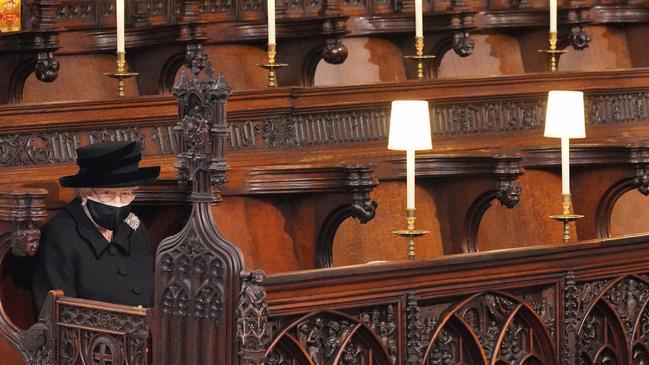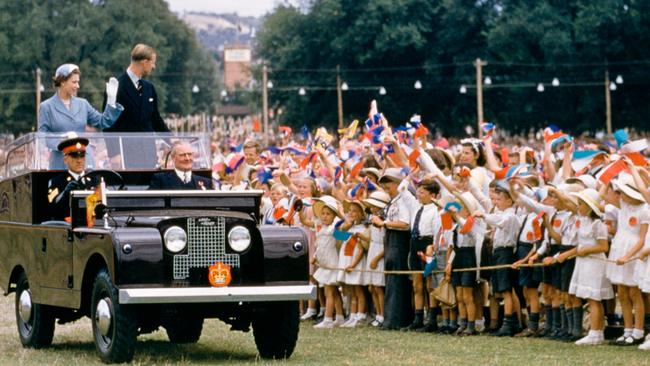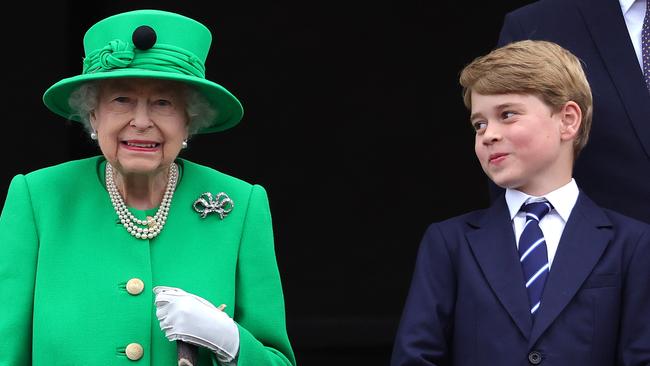Queen Elizabeth II dies at Balmoral, aged 96
In news greeted with profound sorrow across the Commonwealth the monarch has been pronounced dead, after several months of concern about her deteriorating health.

Queen Elizabeth II, Australia’s head of state and Britain’s longest reigning monarch, has died.
In news greeted with profound sorrow across Australia, the United Kingdom and other Commonwealth nations, the 96-year-old was pronounced dead on Thursday afternoon British time (3.30am Friday AEST), following several months of concern about her deteriorating health and weeks after joyous celebrations for her Platinum Jubilee which marked her 70 years on the throne.
Buckingham Palace announced the death of her Majesty at 3.30am AEST: “The Queen died peacefully at Balmoral this afternoon. The King and The Queen Consort will remain at Balmoral this evening and will return to London tomorrow,” the Palace said in a statement.
A statement from His Majesty The King: pic.twitter.com/AnBiyZCher
— The Royal Family (@RoyalFamily) September 8, 2022
On Thursday at lunch time (early Friday AEST) there was immediate alarm when Buckingham Palace announced the Queen was under constant medical supervision after concern from The Queen’s doctors.
Then followed some immediate worries expressed by the prime minister Liz Truss, in the House of Commons, who broke away from debate on a crucial energy announcement.

The Queen had last been seen in public, carrying out constitutional duties in meeting the outgoing prime minister Boris Johnson and then anointing Ms Truss as the new British prime minister on Tuesday, but she was so exhausted she then cancelled a zoom call with the Privy Council on Wednesday.
Under Operation London Bridge, which is the detailed logistics plan developed over decades to deal with the Queen’s death, a sub-plan called Operation Unicorn is to be enacted because the Queen has died in Scotland.
The Queen’s body is to be taken from Balmoral Castle to Edinburgh on a special train and she will rest in state at the Palace of Holyroodhouse.
Her coffin will be then carried to the St Giles Cathedral on Edinburgh Royal Mile where it is anticipated people can pay their respects.
The Queen’s body will then be taken to Waverley Station in Edinburgh and placed on the Royal Train for carriage to St Pancras, where she will be met by Prime Minister Truss and members of her cabinet.
The first sign that all was not well with the 96-year-old Queen was that a helicopter landed in Balmoral Castle on Thursday morning but left without its passenger, Prince Charles.
Seventy-three-year-old Charles, the first in line to the throne, had left Dumfries House in Ayrshire where he was hosting a two day global symposium on allergies, organised by the Natasha Allergy Research Foundation, to travel back to Balmoral and see his ailing mother.

At the same time Princess Anne, who was also in Scotland carrying out royal duties, also arrived at Balmoral to be beside her mother.
In recent weeks the Queen had been spotted out and about on the Balmoral Estate visiting the fishing hut favoured by the Queen Mother, and walking slowly with her stick, with corgis running about. But just days ago she missed one of her annual highlights, the Braemar Highland Games, for the first time in her 70-year-reign, adding to a growing list of cancelled engagements ranging from the opening of the Birmingham Commonwealth Games, COP 26 and the Remembrance Sunday Cenotaph service, after dealing with episodic mobility issues which the public was told about last October.
But when the Queen cancelled a zoom call on Wednesday with the Privy Council, so fatigued by Tuesday’s activities of greeting outgoing Boris Johnson to accept his resignation and then anoint her 15th prime minister Liz Truss, there were hopes that the Queen could rally after some rest.
It is believed Aberdeen doctors who regularly attend to the Queen when she is in Balmoral for her summer break, had been overseeing the Queen’s big day on Tuesday in consultation with her chief medical doctor Professor Sir Huw Thomas.
Professor Thomas and other doctors attended to the Queen on Thursday morning.
At 12.27pm in the House of Commons the party leaders appeared to be receiving secret briefings.
In Westminster Ms Truss had just delivered her plans to address the catastrophic energy crisis enveloping the nation when the Chancellor of the Duchy of Lancaster, Nadhim Zahawi, came into the Chamber and began whispering to her while Labour leader Sir Keir Starmer was responding.
Labour deputy Angela Rayner was also handed a note which she passed to Sir Keir.
At 12.30pm Buckingham Palace had issued a highly unusual statement to the media saying: “Following further evaluation this morning, The Queen’s doctors are concerned for Her Majesty’s health and have recommended she remain under medical supervision.The Queen remains comfortable and at Balmoral.”

Minutes after Ms Truss and Sir Keir tweeted their worries and the nation was immediately deeply concerned. There was a feeling that this was a highly significant moment in history.
Commons Speaker Sir Lindsay Hoyle interrupted the speech of SNP Westminster leader Ian Blackford saying: “I know I speak on behalf of the entire House when I say that we send our best wishes to Her Majesty the Queen and that she and the royal family are in our thoughts and prayers at this moment.”
Within minutes newsreaders had switched to black dresses, jackets and ties.
At 12.40pm the BBC pulled its scheduled programming and reverted to rolling news on the Queen’s health.
The second in line to the throne, Prince William, abandoned plans to pick up his three children from their first full day at their new school, Lambrook, leaving the Duchess of Cambridge, Kate to do the school run, and he headed to RAF Northolt in South Ruislip, west London.
There he met up with Prince Andrew, Prince Edward and his wife Sophie, and the four flew to Aberdeen on a Royal Air Force jet at 2.39pm, arriving at Balmoral at 4.37pm.
Prince Harry, who with wife Meghan Markle happened to be in the United Kingdom to attend the WellChild Awards in London, cancelled their charity appearance.
While their spokesperson initially said both Harry and Meghan would travel to Balmoral, by 4.30pm, it was announced that only Harry was making his way to Scotland while Meghan remained in London.
The Queen’s passing signifies the biggest constitutional change in seven decades – Her Majesty acceded to the throne on February 6, 1952 when aged just 25 and now Australia, the United Kingdom and 14 other Commonwealth countries have a new monarch, King Charles III, as head of state.
The Accession committee of the Privy Council, which is meeting in the next few hours will officially proclaim King Charles at 10am London time (7pm Sydney time) with an announcement at St James’s Palace and the Royal Exchange in the City of London, as well as in Scotland, Wales and Northern Ireland and Canberra. It is expected the coronation of the 73-year-old will occur within months.

Charles’ wife, the former Duchess of Cornwall, is now Queen Camilla, despite some public pushback about her role in Charles’s failed first marriage to Diana, the Princess of Wales.
In time, the heir to throne, Prince William, 39, is to become the Prince of Wales and his wife Kate the new Princess of Wales.
Details of the Queen’s funeral at Westminster Abbey are yet to be announced, but it is expected to be held in ten days’ time in a Day of National Mourning.
The Queen had worked with her courtiers on the funeral details and it is anticipated a committal service will be conducted in one of her favourite churches, St Georges Chapel at Windsor Castle where the scaled back funeral of her ‘’strength and stay’’ Prince Phillip, 99, was held in April this year.
One of the most poignant images of the Queen during her reign encompassing the entire sweep of Britain’s post war history was of her sitting utterly alone in the chapel, grieving for her husband of 73 years amid the coronavirus pandemic.
It evoked memories of a pale and solemn Queen in 1952 sorely missing her father, King George, as she arrived back from a tour of Africa and then being heavily veiled for his funeral.
At the time her grandmother Queen Mary spoke of the pressures of the young 25-year-old becoming Queen: “I only hope they will not kill the poor little girl with overwork”.
Yet it was this “poor little girl” who has fortified a nation from the time of her 1953 coronation through times such as the Suez Crisis, the Aberfan disaster, the introduction of decimal currency, Britain entering the common market and then leaving it with Brexit, and Australia’s own constitutional crises in 1975 with the sacking of the Gough Whitlam government and the mystery disappearance of prime minister Harold Holt in 1967.
In her time she provided stability and counsel for 15 British prime ministers and 16 Australian prime ministers.

The Queen’s coronation in 1953 had been seen to have begun with a high point as it was televised and also coincided with the news that Everest had been finally conquered by New Zealander Edmund Hillary and Nepalese Sherpa Tenzing Norgay of the British Mount Everest Expedition, led by Col John Hunt.
Australians have happy memories of the Queen’s tours Down Under from 1954 through to 2011 when she started to wind back her travel. In 2011 the Queen said: “Ever since I first came here in 1954 I have watched Australia grow and develop at an extraordinary rate. This country has made dramatic progress economically in social scientific and industrial endeavours and above all in self-confidence”.
Charles has also spoken about his formative time at the Victorian school Timbertop and it is anticipated that after touring the United Kingdom, he will embark on a series of overseas engagements including to Australia.

The Queen will be buried at Windsor Castle’s King George VI Memorial Chapel alongside Philip.
In the meantime as world leaders descend on London, the public will be allowed to view the Queen lying in state in Westminster Hall for 23 hours a day in the three days prior to the funeral.
This Hall – first built by William II in 1097 and with magnificent oak rafters of Richard II – has witnessed centuries of historic occasions including the laying in state of the Queen’s father King George VI, coronations of various Kings and famous trials. Tens of thousands of people are expected to queue throughout central London during the 90 hours of viewing.

Already there is a massing of people around The Mall near to Buckingham Palace and in Windsor at Windsor Castle.
The Queen’s death has been marked with an immediate lowering of flags from 10 Downing Street and all around the nation to half-mast and gun salutes have been taking place at all saluting stations. The great bell of St Pauls has begun to peel.
An official mourning period has begun, and all comedies, theatre and sporting events have been cancelled.
Government websites are now coloured black and routine announcements have been postponed.
The new monarch, grieving for his mother, will make a broadcast to the nation around 6pm in London which is in the early morning Australian time.
It is unclear if he and other members of the Royal Family, the Queen’s other sons Prince Andrew and Prince Edward and her daughter Princess Anne will also attend a service of remembrance at St Paul’s Cathedral in London later today.
The Queen’s death was relayed to the Australian governor-general David Hurley and in a cascade of calls and emails through diplomatic and official channels, officials were notified by the Queen’s private secretary Sir Edward Young, who has been with the Royal Household for 17 years and British Conservative politician Penny Mordaunt who is the Lord President of the Privy Council.
Australia’s 92-year-old former leader of the National Party and Speaker of the House of Representatives, Ian Sinclair, is a member of the Privy Council.









To join the conversation, please log in. Don't have an account? Register
Join the conversation, you are commenting as Logout